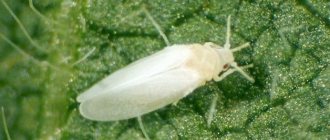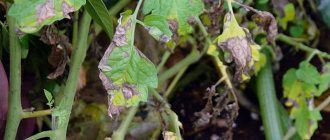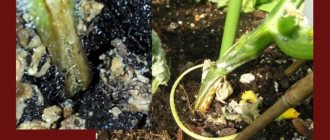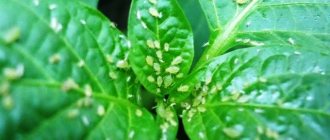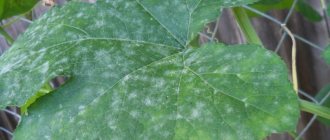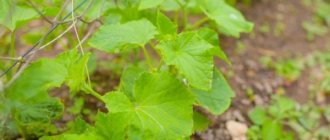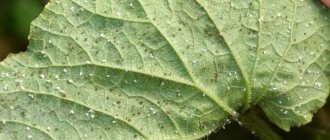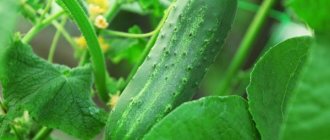Dacha crops are demanding of care and sensitive to diseases. Fungi, bacteria, pests attack day after day.
It is not surprising that sometimes one gives up in the fight against all kinds of diseases. Trying to protect the harvest, summer residents use different methods - chemical, biological, folk. But there are diseases that are very difficult to cope with. For example, late blight. We'll tell you what late blight is, why it appears on cucumbers and how to fight it, and photos will help you better understand the problem.
What is late blight
A plant disease, the name of which is translated from ancient Greek as “destroying,” “destroying,” “disastrous,” is late blight.
Phytophthora is a genus of fungi that infects plants and causes disease. There are about 100 species of late blight mushrooms.
It reproduces by zoospores, which tolerate wintering well in the ground, are cold-resistant, and love warmth and moisture. If the disease is not detected at the initial stage, it is difficult to cure. In case of deep damage, a radical method is used - they completely get rid of the plants.
Fighting methods
Sometimes, even with proper care and prevention, it is not always possible to avoid late blight. Treatment must follow immediately, as the infection spreads quickly between crops and can destroy the entire crop.
The main rule in fighting the disease is following the rules of care.
- Water the cucumber bushes as the top layer of soil dries and do not allow moisture to stagnate.
- You cannot use a hose for watering; use the sprinkling method or water each bush with a ladle or watering can near the root.
- Make sure that the plantings do not thicken. A gap of 40-50 cm is maintained between the bushes.
- Regularly weed the beds and loosen the soil.
- Do not lime the soil.
- Fertilizers are applied regularly (alternate organic and mineral compositions).
- When signs of disease appear, the affected bushes are destroyed.
Reasons for the appearance of late blight on cucumbers in greenhouses and open ground
Most often, late blight appears in greenhouses and greenhouses, but this problem is not uncommon in open ground. By observing the rules of alternating planting, the proximity of crops and complete cleaning, they achieve the elimination of late blight on their site.
There are many reasons for the occurrence of fungus, mainly air humidity of more than 75% and ambient temperature +15...+20°C.
Other reasons:
- open ground is characterized by sharp changes in warm daytime and cold nighttime air temperatures;
- frequent and abundant watering of cucumbers contributes to flooding of the soil under the plants;
- high ambient humidity at the same time low air temperature;
- dense planting of cucumber bushes in a greenhouse;
- an incorrectly selected planting site that receives little sun;
- exceeding the permissible lime content in the soil;
- the seed material was not disinfected before sowing;
- if the proximity of crops on the site is disturbed, the infection enters the cucumber beds from the outside;
- improper or insufficient feeding of plants, poor soil and, as a consequence, weakness of plants in resisting diseases;
- insufficient ventilation of greenhouses;
- crop residues or tops are not removed for the winter;
- diseased bushes are removed, but not destroyed, which is why the fungus from the compost pit gets back into the beds;
- on open ground, the wind causes fungal microspores to spread throughout the area, so fences or alternation with beds with high tops are necessary;
- Infected bushes were not removed immediately after the disease was detected, and the disease was allowed to transfer from one plant to another.
Advantages and disadvantages of chemicals
Advantages:
- Large selection of drugs on the market;
- Highly effective in the fight against late blight fungus and its spores;
- Some drugs have not only medicinal, but also stimulating properties.
Flaws:
- If used incorrectly, some chemicals can seriously threaten human health and pollute the environment;
- Personal protective equipment must be worn when using some fungicides;
- Some chemicals are expensive.
Signs of late blight
It’s easy to miss a disease. It begins to appear as small brownish-brown spots on the leaves, as in the photo.
If the leaf is turned over, a white cobweb is visible on the underside, barely perceptible to the eye. In the next stage of damage, the leaves begin to curl, turn yellow and fall off.
The absence of ovaries also signals the development of late blight. If fruits are present, soft brown spots form on them, similar to rotting areas. Sometimes, when the disease is advanced, there is a persistent smell of rot.
Mistakes when growing cucumbers
Most often, the spread of late blight is provoked by incorrect human actions. Due to inexperience or ignorance, he performs a number of actions that contribute to the spread of pathogenic microorganisms.
It may be interesting How to properly care for cucumbers in the open ground so that there is a good harvest Which varieties of cucumbers are suitable for greenhouses in the Moscow region: the best names for 2021 Application, dosage and rules for feeding cucumbers with boric acid
- Incorrect watering. Very often, cucumbers are watered according to a schedule, without taking into account the condition of the soil and plants, which creates a favorable environment for the development of spores.
- Using diseased plant residues when laying compost. Fungal spores can be stored in soil or plant debris for a long period. Using last year's infected tops as compost will lead to re-infection of the site.
- Watering with a hose. Cucumbers should be watered strictly near the root. The moisture that falls on the leaves remains on them and becomes an excellent medium for the proliferation of spores.
- It’s a big mistake to start fighting when signs of the disease appear. It is more advisable to carry out preventive treatments and other measures from the moment cultivation begins.
With proper preparation of the soil and plants, as well as compliance with all care rules, the likelihood of late blight developing in cucumbers is minimal. To avoid this unpleasant disease, plantings should be treated for preventive purposes. Such sprays will help strengthen the immune system and cope with the disease at the earliest stages of development. If damage does occur, treatment begins immediately.
What is the danger
Late blight itself is not dangerous to humans. You can safely eat fruits affected by late blight. However, no one wants to eat rotten cucumbers and other vegetables. In addition to their unattractive appearance, they also have a corresponding smell. Cucumbers from an already cured bush also look unappetizing. They are unevenly colored and have bumps.
The danger lies in the survivability of this type of fungus: it is not afraid of cold and heat. Once faced with this disease, summer residents then try for years to remove it from the site.
The disease affects cucumbers, tomatoes, eggplants, and potatoes. Affected plants do not bear fruit: tomatoes do not turn red, cucumbers do not set, potatoes lose their tops and do not form tubers. The result is a meager harvest or its complete absence.
Cucumber varieties resistant to late blight
When purchasing seeds for growing cucumbers, it is recommended to choose unpretentious and disease-resistant hybrid varieties. Here are the best ones:
- Tom Thumb. An early ripening hybrid variety, characterized by resistance to most fungi and bacteria, including late blight. Thanks to early ripening, there is a chance to have time to harvest before the onset of the rapid phase of disease development. These cucumbers are ideal for canning and pickling.
- Pasadena. A mid-early hybrid, genetically without bitterness. Also very resistant to fungi and bacteria.
- Masha. An extremely unpretentious variety to growing conditions and disease-resistant. It begins to bear fruit a month after germination - you will have time to harvest the crop before the infection begins to develop.
- Goosebumps. Mid-season self-fertile hybrid, resistant to most common diseases. It has high productivity.
- Martin. This aromatic bee-pollinated variety is also characterized by complex resistance to fungal attack and has no bitterness.
- Natalie. Medium-sized hybrid for protected ground. It is distinguished by high taste and commercial qualities, resistance to fungi and adverse weather factors.
- Chinese disease resistant. A powerful plant with unique resistance to all typical cucumber diseases, severe temperature changes and poor lighting. The fruits are very long (30-35 centimeters), with pronounced taste.
- Competitor. An old variety, tested by experienced summer residents. It is characterized by high productivity and resistance to diseases.
- Benefit. It does not need bees for pollination; it is self-fertile. Cucumber is not bitter and has a strong aroma and taste.
In addition to everything described in the article, we recommend putting into practice the advice of experienced gardeners:
- for better resistance to late blight and similar ailments, it is important to strengthen the root system of the bushes - form additional adventitious roots by pressing the stems to the ground and sprinkling them with moist soil;
- if there are few insects, a problem arises with pollination of cucumbers. To increase the number of ovaries, work as a bee - with the help of a soft brush, pollen is easily transferred from flower to flower;
- if you regularly (every 2 weeks) feed cucumbers with milk diluted in a 1:2 ratio with water, this will accelerate growth;
- after each watering and rain, the top layer of soil compacts and forms a crust, which cracks and breaks the root system of the bush. Therefore, it is important to loosen the soil;
- cucumbers do not tolerate proximity to tomatoes; they feel best next to legumes, cauliflower and lettuce;
- do not wait until the greens gain the desired weight - the more often you collect the fruits, the better the yield.
It’s not for nothing that cucumbers have won worldwide recognition: they are our favorite pickles, a popular snack and a proven budget cosmetic product. Monuments to the “green breadwinner” installed all over the world are fair proof of this.
Methods of control, treatment regimens and recipes
Late blight on cucumbers can be treated in the initial stage of the disease. The more serious the stage of infection, the less chance of cure. We will tell you in more detail how to fight the disease in a greenhouse and open ground.
Chemicals
In specialized stores for summer residents there are many chemicals to combat late blight. But they should be used with caution and if it is impossible to fight with milder means. After use, do not eat the fruits for a month to avoid poisoning.
The most effective means:
- "HOM" is a fungicidal drug. Refers to contact pesticides of inorganic origin. Used for spraying. To do this, 40 g of the drug is diluted in 100 ml of water, and then, with constant stirring, the water is added to 10 liters.
- “Oxychom” (copper oxychloride + oxadixil) is a contact-systemic fungicide against late blight. Dilute 1 packet (4 g) per 2 liters of water. Plants are sprayed as necessary up to three times with an interval of 10-14 days.
Biological methods
Biological drugs have a milder effect on the environment and humans. However, they are not as active against fungi.
Treatment is carried out in the initial stages of the disease:
- "Fitosporin-M" is a biofungicide in the form of a dark brown paste, liquid or powder. Powder or paste is used in gardening. For spraying, dilute 10 g of powder in 5 liters of water or 3 tsp. pasta in 10 liters of water.
- Copper sulfate. Helps well when spraying. 2 tbsp is enough. l. for 10 liters of warm water.
LATE BLHA - The epidemic has begun! Together with me, we treat tomatoes and cucumbers against late blight!
Folk remedies
If you manage to identify the first signs of late blight, folk methods can also cope with the onset of the disease.
They are completely safe:
- Yeast. 100 g of yeast are diluted in 10 liters of warm water and the affected plants are watered with the resulting solution.
- Garlic and potassium permanganate. Grind 100 g of garlic into a pulp, pour a glass of water and leave to brew for a day. Afterwards, the tincture is diluted in 10 liters of water and 1 g of potassium permanganate is added. Spray the affected plants with the resulting solution every 10 days until fruit sets.
- Wood ash. A week after planting the seedlings, but before the fruit sets, the row spacing is sprinkled with ash between watering the plants, leaving time for the ash to absorb excess liquid.
- Milk serum . Dilute the whey from sour milk with water in equal proportions and spray the resulting solution on the seedlings in July.
- Table salt. Use simple, coarse salt, not extra. Dilute 1 glass of salt in 10 liters of water and spray the green fruits once a month.
How to recognize the disease, the causes of late blight
The disease quickly spreads from a diseased plant to a healthy one; the wind carries fungal spores over long distances. Late blight infection occurs when there are diseased cucumbers and plant fragments in the garden, or when infected fruits are stored. Weakened crops are most susceptible to late blight. Causes of the disease:
- use of infected planting material;
- excess lime in the soil;
- high humidity, excessive watering;
- dense plantings;
- weather conditions: fog, sudden temperature changes during the day;
- the ventilation regime in the greenhouse is not observed;
- cucumbers grow in a shaded area.
Signs of late blight often appear towards the end of summer. At the initial stage of the disease, the leaves change color and curl. As the disease progresses, the formation of ovaries stops, the plant stops growing and developing. The fruits begin to rot.
The smell of rot appears in the area; weakened plants attract harmful insects. The fungus multiplies on the leaves and shoots of cucumbers, the spores move to healthy bushes, and the soil becomes infected. Cucumber plantings are susceptible to fungal and viral diseases.
Important! The most favorable conditions for fungus are temperature range +10...+25ºС, humidity from 75%.
How to treat the soil after infected cucumbers
After harvesting, even with the slightest signs of disease, the soil is disinfected. Fungal spores thrive in the soil for many years.
In the fall, after all the bushes have been removed, they begin to cultivate the soil using any of the following methods:
- the beds are dug up and watered with a solution of copper sulfate;
- 10 g of “Fitosporin” are dissolved in 1 liter of warm water and fertilize the beds;
- water the soil with a solution of potassium permanganate - 2 g of the substance per 10 liters of water;
- dig up soil with wood ash.
The greenhouse itself is not ignored:
- if possible, treat the structure of the greenhouse (greenhouse) with a steam cleaner;
- washed with “Farmayod”;
- remove the top layer of soil in the greenhouse and replace it with a new one;
- sow white mustard and, before flowering, dig up the soil, burying the mustard stems inside the bed.
Prevention measures
If you do not take any measures against late blight of cucumbers and peppers, then as a result there is a high probability of losing a significant share of the crop (from 50 to 90% of the forecast). At the same time, you should not panic and immediately buy chemicals; it is better to start taking preventive measures long before sowing seeds or planting seedlings.
- Late blight spores can live on the seeds of cucumbers and peppers. If you prepare seed yourself, then do it in those years when late blight was not in your garden bed. Do not buy cucumber seeds from random people; it is better to do this in specialized stores or nurseries;
- Start preparing the area for cucumbers and peppers in the fall. Clear the bed of dried leaves and stems (they may contain late blight spores), dig up the soil and disinfect it with ash infusion or copper sulfate solution;
- When growing cucumbers and peppers in a greenhouse, treat the soil and disinfect the room, as fungal spores can live on frames, windows and greenhouse structures. Tobacco or sulfur bombs will help you destroy the parasite (Photo);
- When planning a site, try to avoid the proximity of crops prone to late blight: cucumbers, tomatoes, peppers, potatoes;
- Do not overcrowd the beds - your cucumber and pepper bushes should be well ventilated by the wind. Ventilate and ventilate the greenhouse regularly.
- It is important to avoid touching the leaves to the ground, which is where the late blight pathogen comes from;
- Avoid overwatering; water the cucumbers only after the top layer of soil has dried out. It is better to do this early in the morning;
- Try to add a sufficient amount of minerals such as phosphorus, potassium, copper salts; do not overuse nitrogen fertilizers;
- Keep the area clean, do not forget to remove infected leaves, branches and fruits: they are the source of infection for cucumbers, tomatoes, peppers and other vegetables.
Prevention
If you follow a few rules, the disease will not appear in your summer cottage:
- alternate planting sites;
- plant varieties that have strong immunity to late blight;
- regularly ventilate the greenhouse;
- do not allow the bed to become waterlogged;
- burn infected bushes and do not use them as compost;
- feed the seedlings with potassium-phosphorus fertilizers;
- disinfect seeds before planting by soaking them in a weak solution of potassium permanganate.
Is it possible to eat infected cucumbers?
Vegetables affected by late blight usually spoil very quickly. However, if you still manage to harvest the crop, you can eat such vegetables, since the disease does not affect human health.
However, such cucumbers have an unpleasant appearance and poor taste.
Gardeners advise not to use damaged vegetables for winter harvesting, since the processing process increases the acidity level. Such preparations quickly deteriorate and can lead to poisoning.
Late blight of cucumbers - photos and experience in combating it
Late blight is fraught with unpleasant consequences because it rapidly progresses in its development. Without proper rescue measures, this can lead to a complete loss of the harvest of not only tomatoes, but also cucumbers.
How does the disease manifest itself?
Europe did not know late blight until the middle of the last century. The infection was brought from overseas along with a cargo of potatoes. He came to our country much later, but found here comfortable conditions for his development.
The causative agent of late blight is the late blight fungus. Today more than a hundred of its varieties are known, and in general biologists suggest that there are at least five hundred of them, descriptions have been compiled.
This fungus is quickly transferred from one plant to another. This happens even when the wind blows. In addition, fungal spores are carried by birds and insects. And rains only aggravate the situation; they wash away spores from plants, and when they get into the soil, they begin to develop, turning directly into fungi.
In the future, spores can even develop in the tubers of root crops and in the fruits of vegetable crops remaining in the soil after harvesting.
Fungal spores begin to rapidly develop when air humidity exceeds 75 percent and the ambient temperature drops to 10 - 25 degrees.
Why late blight appears on cucumbers
There can be many reasons for this disease. Here are the main ones:
- Sharp changes in day and night air temperatures.
- Flooding of the soil under cucumbers due to excessive watering or frequent rains.
- High humidity of the surrounding air at low temperature.
- Excessive planting density of cucumbers.
- Shaded area.
- Increased lime content in the soil.
- The seed material was not disinfected before sowing.
- The infection entered the cucumber beds from the outside.
- Weakness of plants due to poor soil or improper management of them.
- Poor ventilation of greenhouses.
- Harvest residues or tops have not been removed for the winter.
What do cucumbers infected with late blight look like?
The first signs of late blight infection on plants are small spots of brown color with a brown tint. They may appear on the leaf or stem of the plant. Later, a coating of thick cobwebs appears on the underside of the leaves, causing them to curl into tubes and fall off.
When infected with late blight, the growth of cucumber stems is greatly slowed down, and the formation of a new ovary stops.
The manifestation of the fungus can also be on the cucumbers themselves. Small brown depressions appear on them, under which the fruit pulp softens. Then active rotting of the cucumber begins - treatment is already useless.
In the advanced stage of late blight, the entire bush may turn brown, and a foul smell spreads over the cucumber beds.
How can you fight late blight?
This disease is extremely insidious and can occur even with impeccable care for cucumbers. It is imperative to fight it, otherwise the entire crop in the garden will die.
- First of all, strictly follow the rules for caring for cucumbers. You can’t get carried away with watering, it should be moderate and only to the root.
- Planting cucumbers too densely results in poor natural ventilation between the bushes. Musty air is a comfortable environment for fungal spores.
- Keep weeds out between the rows because they restrict air circulation and weaken the cucumbers by consuming nutrients from the soil.
- Loosen the soil under the bushes several times during the season.
- If you grow cucumbers in a greenhouse, ventilate it regularly.
- Without proper feeding, cucumbers will be weak, and late blight primarily affects weakened plants.
- Diseased bushes should not be treated; immediately tear them out by the roots and burn them. Water the soil under them generously with a weak solution of potassium permanganate.
Chemicals against late blight
The most gentle remedy is Bordeaux mixture. An aqueous solution based on it successfully destroys fungal spores. However, you need to remember that excessive concentration of the solution can cause burns on cucumber leaves.
For the first treatment, the product is prepared at the rate of 20 ml of Bordeaux mixture per 3 liters of water. For repeated spraying, the concentration should be weaker. You need to take the same 20 ml of Bordeaux mixture, but not for 3, but for 4 liters of water.
It is important to know that cucumbers should always be sprayed with Bordeaux mixture twice. The interval between treatments is at least two weeks.
If two treatments do not completely help, then this simple procedure can be repeated every 2 weeks until the beds are completely free of infection.
Today, many stronger chemicals than Bordeaux mixture have been invented to rid plants of late blight. Each of them can be used strictly in accordance with the instructions. Gardeners consider the best preparations to be:
- "Alufit";
- "Barrier";
- "Ridomil MC";
- "Oxychom";
- "Tattoo";
- "Bravo";
- "Antrakol";
- "Barrier";
- "Quadris";
- "Ordan";
- "Hom."
It should be remembered that they are all poisons that can cause poisoning. When working with solutions of these drugs, you only need to wear protective clothing and goggles. They should not be used in windy weather or rain. The last spraying can be carried out no later than 2 weeks before the start of harvest.
Folk remedies
There are many folk recipes for combating late blight. Unfortunately, they are not as effective in treatment as chemical drugs. You should not refuse them, as this is an excellent option for preventing the disease.
Garlic infusion with potassium permanganate
This method is effective when the first signs appear. Garlic infusion kills fungal spores and prevents their reappearance. Apply until cucumber ovaries appear.
To prepare an infusion for processing you need:
- Stir 2 tbsp in a bucket of warm water. chopped garlic.
- Leave to infuse for a day.
- The infusion is filtered and 2 g of potassium permanganate is added.
The resulting product is sprayed onto the cucumber plantings with a spray bottle. Re-process after 10-14 days. Can be processed again after 2 weeks.
Wood ash
This method is effective after transplanting seedlings to a permanent place. Spray the plants with a spray bottle before the ovaries begin to form.
Initially, 1.5 kg of wood ash is mixed in 5 liters of water. The resulting mass is infused for 3 days in a dark place under a lid. Bring water to 10 liters, add 2 tbsp. l. crushed laundry soap.
The mixture is infused for another day and the green cucumbers are sprayed with a spray bottle 2 times with a break of 2 weeks.
Yeast
Raw nutritional yeast is effective in combating late blight. Based on them, a solution is also prepared for spraying the green parts of plants.
- 100 g of fresh yeast are dissolved in a bucket of warm water.
- Allow the mixture to ferment for 1-2 days.
- Add 30 ml of iodine to the resulting mass.
The resulting mixture is sprayed onto cucumbers. This composition is not only an excellent remedy for the treatment and prevention of late blight, but also an excellent fertilizer that can strengthen plant immunity and recover.
Diseases of cucumbers in a greenhouse and their treatment. (Photo)
Whey or kefir
Whey-based formulations can be used every week. To prepare the solution you need:
- 1 liter of whey or kefir is poured into a bucket of water.
- Infuse the milk mass for 2 days. The infusion will be ready when a light foam appears on top.
- The composition is mixed well and the plantings are sprayed with it.
With the help of this mixture, they not only fight late blight, but also repel pests from cucumbers. The milk mixture can be used as a foliar treatment, as well as for watering kutas at the root.

